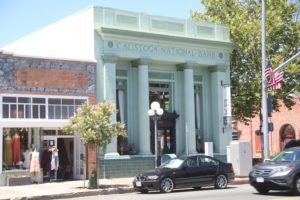

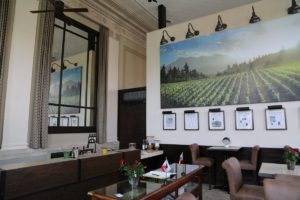 Knights Bridge Winery was founded by photographer and journalist Tim Carl (although Carl is no longer involved in the business). Tim brought on three individuals who became his business partners; James and Essel Bailey (brothers) and Tom Costin; today all three men and their wives are owners of Knights Bridge Winery). James is from the midwest and grew upon a family farm, later graduated from Harvard with a degree in American Colonial History. His career has been remarkably diverse from being an investment adviser, entrepreneur to helping fund the first major domestic geothermal energy company, California Energy. He was also one of the co-founders of Cambridge Associates, a prominent Boston founded and based investment consulting company (with a number of domestic and international offices).
Knights Bridge Winery was founded by photographer and journalist Tim Carl (although Carl is no longer involved in the business). Tim brought on three individuals who became his business partners; James and Essel Bailey (brothers) and Tom Costin; today all three men and their wives are owners of Knights Bridge Winery). James is from the midwest and grew upon a family farm, later graduated from Harvard with a degree in American Colonial History. His career has been remarkably diverse from being an investment adviser, entrepreneur to helping fund the first major domestic geothermal energy company, California Energy. He was also one of the co-founders of Cambridge Associates, a prominent Boston founded and based investment consulting company (with a number of domestic and international offices).
Essel (Jim’s brother) became a lawyer for 20 years after graduating from the University of Michigan. His career has been equally as diverse as his brothers helping manage a variety of companies ranging from auto parts to care for the elderly.
Tom grew up in rural New Hampshire and is also a graduate from Harvard (a degree in Public Administration); he spent a career working in the shoe business – most notably as the CEO of Soletech and as the managing director of Michelin Footwear.
They purchased their Knights Valley Vineyard in 2006 and also released their first estate wines from that year. A year later they began sourcing fruit from two of Napa’s most highly regarded and recognized vineyards, Dr. Crane and To Kalon; the last vintage of these wines was in 2013. Today their focus is entirely on Sonoma County grown fruit with the entirety of their production from their 100+ acre estate in Knights Valley.
Estate Property & Winery
The Knights Bridge estate vineyard is located on the western side of Knights Valley (the neighboring valley just north of Napa Valley), encompassing both valley floor and hillside land. It is a less than 15-minute drive from downtown Calistoga yet feels worlds removed from Napa Valley at times with much less traffic and fewer vineyard plantings. The property ranges in elevation from 300 to 900 feet and approximately half the acreage is planted to a variety of grapes including Chardonnay, Sauvignon Blanc, Sémillon, Merlot, Petit Verdot, Cabernet Franc and the majority, to Cabernet Sauvignon. The vineyards are broken into 17 different vineyard blocks. The views from the upper part of the property are stunning overlooking parts of Knights Valley below with Mt. St. Helena in the background.
Their “neighbor” is the well-regarded Peter Michael Winery on the other side of the valley and can be seen from Knights Bridge. The hillside landscape in this part of Knights Valley is quite varied with many different exposures, soil types and microclimates. Unlike neighboring Napa Valley, Knights Valley is not populated with wineries; in fact, the valley has only two wineries, Peter Michael and Knights Bridge.
The winery construction began in January 2020 and was remarkably completed by August 2021, just in time for that year’s harvest. The winery was designed by Backen Gillam Architects (Bond, Ovid, Futo, Napa Valley Reserve among their more notable winery designs) with the project overseen by Pound Management. Prior to the winery being built, production had always taken place in Napa Valley including originally at The Ranch Winery and later at Laird Family Estate. Visually, despite being located on the upper reaches of their property, the winery casts a very low impact shadow on the surrounding landscape. The primary structure, the fermentation room is built against a side of a hill while the majority of its footprint is underground (14,000 square feet of caves). One end of the main cave portal was left unfished so one can easily see the type of volcanic rock that had to be drilled through.
During construction of the cave, none of the cave tailings were allowed to leave the property. The winery creatively used some of this material in a particular part of their vineyard; they excavated out a lower section of a vineyard block, layered it with part of the rocks drilled out from the cave and then covered it over completely with the original topsoil. The Knights Bridge team refers to this part of the vineyard as the ‘Goldilocks’ block.
The winery incorporates state of the art technology. Tanks were custom made and range in size from 3, 4 to 5-ton capacity corresponding to vineyard block sizes. Each tank is equipped with its own pump which can be controlled remotely using an app. The winery also owns their own optical sorter. A variety of vessels are used for aging their wines including stainless steel, oak barrels and concrete customized tulip-shaped tanks built by Sonoma Cast Stone (the tulip is part of the Essel family crest). And separate climate-controlled rooms within the cave are used for various steps of élevage.
Winery/Cave
Vineyard
In 2022 Knights Bridge Winery purchased additional vineyard acreage neighboring to their property including approximately 40 acres of vines and an existing house which initially was used for housing harvest interns but potentially can be converted into a guest house for clients. Their total vineyard footprint is currently approximately 90 acres (all organically farmed), with some of the grapes sold to other wineries. The name of the winery ties into their location; Knights from Knights Valley and ‘bridge’ paying homage to a bridge on their property but perhaps more importantly referring the fact they bridge both Sonoma and Napa County.
The estate can host a very limited number of visitors each day (seven days a week). Several experiences are offered, each of which follows ‘the path of the grape’. Visitors are greeted at the entrance to their long driveway and then accompanied through the vineyards with a lead vehicle to the winery. Guests are walked through the production area to the cave culminating with a sit down tasting in the comfortable wine salon. Two tastings are offered: the Classic Tasting and the Library Tasting which is highly customized based on guest preferences. And the tastings are paired with a diversity of small bites prepared by their in-house chef. One of the more delicious bites we enjoyed during a recent tasting was the smoked eggplant mousse, topped with two tiny pomegranate kernels. Other experiences may also be offered including hiking with one of their winemakers through the vineyard.
Knights Valley became a Sonoma County appellation in 1983 and is one of the smallest in all of California (only approximately 2,000 acres are planted to vine). Today it is one of eighteen sub appellations within Sonoma County and among the warmest: for reference, Napa Valley has sixteen sub appellations. A number of premium Napa wineries have or currently source fruit from here including Chateau Montelena, Beaulieu Vineyards, Hall, Duckhorn and Beringer among others. Besides grapes, land to the north of St. Helena (not far from Knights Valley) used to be home to the Great Western Mine – a mine rich in cinnabar (rock ore from which mercury was extracted) and then used for processing and extracting gold from the mines in the Sierra Nevada foothills. And a local’s favorite since 1936, Smith’s Mt. St. Helena Trout Farm & Hatchery is not far from the Knight’s Bridge property.
And historical well-known figures have also visited Knights Valley over the years including Robert Lewis Stevenson, who wrote his book, Silverado Squatters from a cabin at the quicksilver mines, high on the slopes of Mt. St. Helena overlooking Knights Valley. Famous painter, whose paintings now sell for millions, Thomas Hill also painted Knights Valley.
KB by Knights Bridge Tasting Room, Calistoga
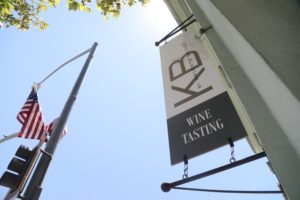
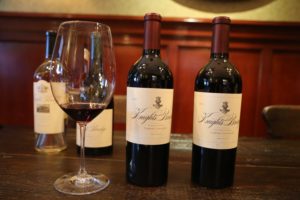
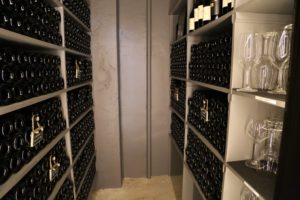 In 2015 the partners purchased the old National Bank Building in downtown Calistoga and initially opened up part of the first floor for tastings of Huge Bear Wines (now a discontinued brand). This tasting room opened on Valentines Day, 2015. This building was built in 1909; during its banking days, it was very well protected with only one entrance and exit into the entire building (perhaps part of the reason it was never robbed).
In 2015 the partners purchased the old National Bank Building in downtown Calistoga and initially opened up part of the first floor for tastings of Huge Bear Wines (now a discontinued brand). This tasting room opened on Valentines Day, 2015. This building was built in 1909; during its banking days, it was very well protected with only one entrance and exit into the entire building (perhaps part of the reason it was never robbed).
With the addition of this tasting room at the time, they completed what was probably a Napa Valley record at the time – three tasting rooms lined up in a row (although one of their neighboring tasting rooms has since closed). In addition to being home to the bank for many years, it also housed a pharmacy and more recently was home for 17 years to Bella Tootsie, a boutique shoe store run by Celeste Navone (Navone Family Wines).
Walking into this room is like walking back in time; the old safe (built by The Hermann Safe Co in San Francisco) is now creatively used to store a variety of Knights Bridge wines.
Tastings are generally of their current releases (Classic Tasting) focusing on the KB by Knights Bridge brand. A Reserve Tasting is also offered; collectors can request tailored tastings specifically for a rare vertical of their To Kalon vintages (with some older To Kalon vintages still available for tasting and purchase bottled under Knights Bridge). And the Private Vault Tasting (by appointment only) is held upstairs in the old bank vault room with wines paired with cheese and charcuterie.
Downtown Calistoga is not large; KB by Knights Bridge is within easy walking distance of other tasting rooms, boutique shops and plenty of restaurants. Street-side parking on Lincoln Ave (the main street) is the closest although there is some limited parking curbside on neighboring streets.
Select Wines
Knights Bridge produces three labels – wines bottled under Knights Bridge, Knights Bridge Pont de Chevalier (means Knights Bridge in French) and KB by Knights Bridge. Some of the names for their wines are tied into family names or places that have personal significance. Knights Bridge tends to age their wines longer than many wineries. As a result, their reds can see up to three years in barrel plus up to another 18 months in bottle before they are released.
Knights Bridge
Seven different blocks of Chardonnay grow on the Knights Bridge estate, typically in the lower cooler parts of the property; the winemaking team produces five different Chardonnay wines. Their West Block Chardonnay vines date from the mid 1980s and were more recently converted to a head trained goblet style. A PVC pipe on top of each of the wooden posts allows vineyard workers to train the canopy in a circular fashion; the team at Knights Bridge refer to these as ‘lollipop’ vines. They are entirely dry farmed. The 2013 Knights Bridge Chardonnay, West Block went through full malolactic fermentation and was aged for 12 months in oak, sur lie (60% new French oak, the remainder used). The pretty bouquet offers aromas of toasted hazelnut, vanilla and citrus blossom. Rounded, supple and creamy this wine delivers plenty of flavor, tending to be more tropical and spice oriented with some notes of orange marmalade, crème brûlée and a touch of oak spice rounding out the finish. This Chardonnay has some noticeable weight.
The 2019 Knights Bridge East Block is medium golden in color; the aromatics are generous and well-layered including of mango, papaya, crème Brule, honeysuckle and honeycomb. This wine’s texture is creamy and supple across the length of the palate. It offers rich flavors including of stone fruit (apricot and peach) along with warm butter and a toasted oak note on the finish. This wine was aged for 11 months in 75% new French oak.
The 2009 Knights Bridge To Kalon Vineyard Cabernet Sauvignon is highly aromatic: a pretty sweetness of fruit shows, along with some floral notes, crème de cassis, a dry dust with a green tea leaf nuance at times. This is an intriguing bouquet. A big wine on the palate – presumably more balanced because of some bottle age. Rich layered fruit flavors including ripe blackberry, cherry and black currant. Great acidity. Coarse tannins persist for some time on a very long finish. We tasted this wine some 8 years after harvest – it is very clear this wine still has plenty of life ahead of it. Fruit, acidity, structure and power; this wine has it all.
We tried this wine again in 2021 – it continues to evolve and show the complexities and life that this particular vineyard is known for. Has changed somewhat since our first tasting with initially savory notes on the bouquet, earthy, mushroom and truffle oil. But this persists only in the beginning; the bouquet quickly evolves to show plenty of fruit. This wine is more balanced now than before and the tannins have been tamed with the extra few years – the acid still shows well.
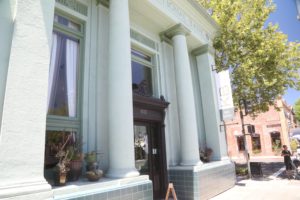

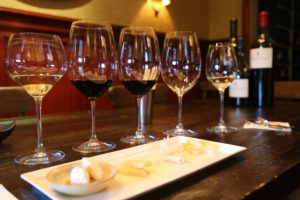 The 2010 Knights Bridge Dr. Crane Cabernet Sauvignon. If one is to categorize wines generically by sex, the To Kalon would be masculine and the Dr. Crane the feminine equivalent. Age has been kind to this wine. The bouquet is rich in depth continuously changing over time to reveal additional nuances. Initially shows darker fruit aromas and opens to more floral notes. Aromas of blackberry and red licorice show. A sweetness of fruit initially shows on the palate, and one also notices how supple the palate is. There are flavors of blackberry and plum along with lingering notes of mocha. The tannins feel wonderful (showing more on the front of the palate then on the finish); they are rounded, smooth and fine-grained. This wine drinks very well with some 7 years of age at the time of our tasting.
The 2010 Knights Bridge Dr. Crane Cabernet Sauvignon. If one is to categorize wines generically by sex, the To Kalon would be masculine and the Dr. Crane the feminine equivalent. Age has been kind to this wine. The bouquet is rich in depth continuously changing over time to reveal additional nuances. Initially shows darker fruit aromas and opens to more floral notes. Aromas of blackberry and red licorice show. A sweetness of fruit initially shows on the palate, and one also notices how supple the palate is. There are flavors of blackberry and plum along with lingering notes of mocha. The tannins feel wonderful (showing more on the front of the palate then on the finish); they are rounded, smooth and fine-grained. This wine drinks very well with some 7 years of age at the time of our tasting.
The Knights Bridge Cabernet Sauvignon is produced from several clones of Cabernet Sauvignon growing in a diversity of vineyard blocks – each with its own exposures and soil types. This is their flagship wine. The 2018 Knights Bridge Cabernet Sauvignon is dark ruby in the glass; the bouquet offers aromas of violets, lavender, old cedar box and blackberry and dark plum. The palate offers flavors of blackberry and mulberry complemented by texturally pleasing tannins showing a fine grained and supple feel. The wine also finishes with a nice lift of acidity. This is a food friendly bottling.
The 2010 Knights Bridge Cabernet Sauvignon Knights Valley (tasted 12 years post vintage from a half bottle) is garnet in color with some slight brickish red at the edge of the rim; the bouquet immediately offers aromas of brown chocolate and cocoa powder along with other baking spices. The fruit is still there (cooked blackberry and a hint of boysenberry) but with its age has certainly taken a significant step behind the tertiary aromatics. The palate offers flavors of both dark and red plums along with dark chocolate. The tannins are chalky, dusty and very rounded; this wine also lingers with a note of tobacco smoke and leather.
The 2016 Haggerty Cabernet Sauvignon is arguably the most complex of the estate red wines we have tried over the years. It is dark ruby in color and almost opaque to look at in the glass; the bouquet offers darker fruit aromatics including cherry and plum along with old cedar box. One can notice more of the oak influence on this wine than some of their other red bottlings. The density of both the darker fruits and tannins are a noteworthy characteristic of this wine. It finishes somewhat savory with dark fruits, crushed pepper, earthy and densely distributed tannins and a lingering hint of dried tobacco leaf. And this finish is refreshingly complemented with a brightness of acidity.
Knights Bridge Pont de Chevalier
The 2015 Knights Bridge Estate Pont de Chevalier Sauvignon Blanc was put through full malolactic fermentation – 15% was aged in barrel, the remainder in stainless steel tanks. The wine was in bottle for a year before release. The bouquet might lead one to believe the palate is more of a New Zealand style wine of this variety with aromas of cut grass and lime. One might think there is even a little Sémillon blended in (based on the weight of the palate) but in reality, this wine is 100% varietal. Shows pleasing rich flavors, good acidity (but not overly so) and is creamier than most Sauvignon Blancs we have tried. There is a hint of spice on the finish.
KB by Knights Bridge
The 2019 KB by Knights Bridge Unoaked Chardonnay is medium gold in color: very floral on the aromas including forward notes of honeysuckle, jasmine, citrus blossom and a vanilla sweetness. The wine offers a lovely texture with a noticeable creaminess. Flavors of mandarin, melon, pear and notes of butter, which are more noticeable on the finish. Lingers with a brightness of acid, a persistent and long-lasting richness of fruit and accompanying dessert spices (certainly not from any oak as this wine does not see any oak during fermentation or its aging). Drinks very nicely by itself.
Huge Bear Wines
Huge Bear was named in tribute to this particular Grizzly Bear as well as an honor to California’s Bear Flag. Incidentally Thomas Knight (namesake for Knight’s Valley) was helping raise the Bear Flag in support of an Independent California during these times.
The label/logo on their bottles of wine also has historical ties – it is an adapted illustration from the children’s book, The Biggest Bear by Lynd Ward – one of the earlier winners of the prestigious Caldecott Medal (in 1953). Ward was a prolific illustrator (over 200 books). Huge Bear added their own twist to the illustration – including the addition of the basket and the bunches of grapes. And one of the better-known quotes from this book, “better a bear in the orchard than an orchard in the bear”!
—
Distribution is currently limited to mostly parts of the east coast of the U.S. including Boston and New York. Total production between all their wines is around 6,000 cases per year. For more information, to schedule a visit, to join their mailing list, to join the KB Wine Club or to join one of their Curated Collections (Noble Collector or Grand Collector), please visit: www.knightsbridgewinery.com



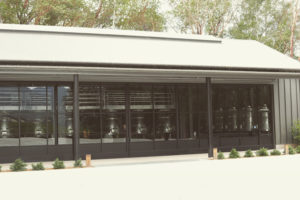





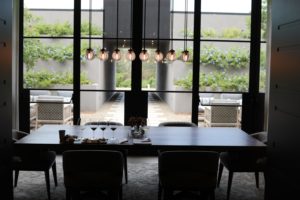
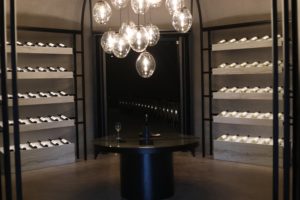

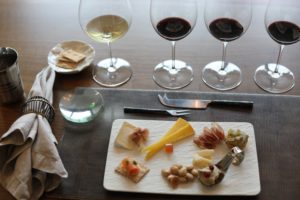


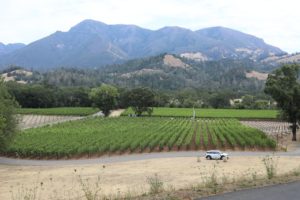
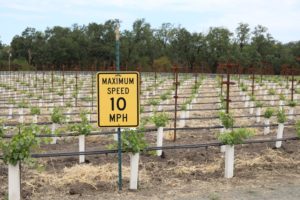
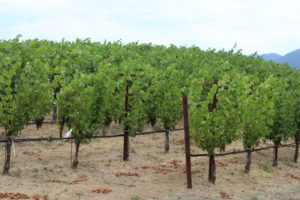
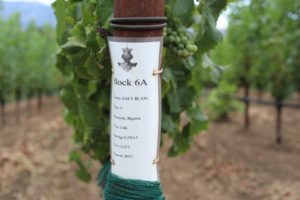
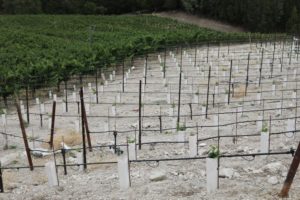
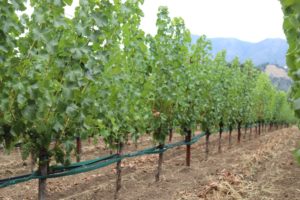

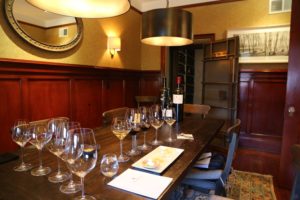


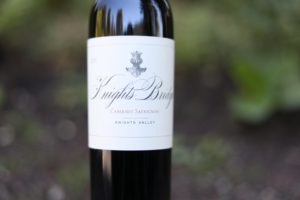
Leave a Reply